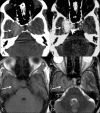Case report: Thrombosed giant cavernous carotid artery aneurysm secondary to cervical internal carotid artery dissection: An unusual entity
- PMID: 22013300
- PMCID: PMC3190497
- DOI: 10.4103/0971-3026.85373
Case report: Thrombosed giant cavernous carotid artery aneurysm secondary to cervical internal carotid artery dissection: An unusual entity
Abstract
Spontaneous thrombosis of a giant intracranial aneurysm with parent artery occlusion is known. The exact mechanism is however unclear and various theories have been proposed. We present an unusual case of an angiographically documented cervical internal carotid artery (ICA) dissection, which led to total occlusion of the ICA distal to the dissected site, with acute cessation of forward blood flow. This resulted in acute upstream thrombosis of the giant cavernous carotid artery aneurysm and an acute cavernous sinus syndrome-like presentation.
Keywords: Cavernous carotid artery; dissection, giant aneurysm; internal carotid artery; thrombosis.
Conflict of interest statement
Figures


Similar articles
-
Spontaneous Thrombosis of a Giant Cavernous Internal Carotid Artery Aneurysm and Parent Vessel Occlusion in a Patient With Bilateral Cavernous Internal Carotid Artery Aneurysms.Cureus. 2023 Feb 20;15(2):e35231. doi: 10.7759/cureus.35231. eCollection 2023 Feb. Cureus. 2023. PMID: 36968945 Free PMC article.
-
A pediatric case of completely thrombosed giant cavernous carotid aneurysm with ipsilateral ICA occlusion mimicking an intra-axial cystic lesion: a case report and review of the literature.Childs Nerv Syst. 2022 Sep;38(9):1809-1812. doi: 10.1007/s00381-022-05481-z. Epub 2022 Mar 8. Childs Nerv Syst. 2022. PMID: 35260912 Review.
-
Completely Thrombosed Giant Intracranial Aneurysm with Spontaneous Thrombosis of the Parent Artery: Is It Nature's Divine Intervention and a Self-Cure?World Neurosurg. 2018 Oct;118:132-138. doi: 10.1016/j.wneu.2018.07.072. Epub 2018 Jul 17. World Neurosurg. 2018. PMID: 30026148
-
Spontaneous thrombosis of a giant cavernous-carotid aneurysm with simultaneous ipsilateral complete parent artery occlusion: a rare phenomenon and review of the literature.Arch Clin Cases. 2023 Feb 20;10(1):21-28. doi: 10.22551/2023.38.1001.10234. eCollection 2023. Arch Clin Cases. 2023. PMID: 36814678 Free PMC article.
-
Spontaneous thrombosis of giant cavernous internal carotid artery aneurysm in a neonate. Case report and review of the literature.Pediatr Neurosurg. 2008;44(4):329-32. doi: 10.1159/000134926. Epub 2008 May 27. Pediatr Neurosurg. 2008. PMID: 18504421 Review.
Cited by
-
Giant Dissecting Aneurysm of the Internal Carotid Artery in a 35-Year-Old Patient: A Case Report.Cureus. 2024 Aug 20;16(8):e67353. doi: 10.7759/cureus.67353. eCollection 2024 Aug. Cureus. 2024. PMID: 39310566 Free PMC article.
References
-
- Whittle IR, Williams DB, Halmagyi GM, Besser M. Spontaneous thrombosis of a giant intracranial aneurysm and ipsilateral internal carotid artery. J Neurosurg. 1982;56:287–9. - PubMed
-
- Kurokawa R, Kuroshima Y, Yoshida K, Kawase T. Spontaneous thrombosis of intracavernous internal carotid artery aneurysm and parent artery occlusion in patients with positive balloon test occlusion.Two case reports. Neurol Med Chir (Tokyo) 2001;41:436–41. - PubMed
-
- Kasliwal MK, Suri A, Sai Kiran NA, Sharma BS. Spontaneous Thrombosis of giant cavernous internal carotid artery aneurysm in a neonate: Case report and review of the literature. Pediatr Neurosurg. 2008;44:329–32. - PubMed
-
- Tsutsumi M, Kazekawa K, Tanaka A, Ueno Y, Nomoto Y. Spontaneous thrombosis of a giant intracavernous internal carotid artery aneurysm and ipsilateral internal carotid artery occlusion. Radiat Med. 2002;20:261–3. - PubMed
-
- Perrini P, Bortolotti C, Wang H, Fraser K, Lanzino G. Thrombosed giant intracavernous aneurysm with subsequent spontaneous ipsilateral carotid artery occlusion. Acta Neurochir (Wien) 2005;147:215–6. - PubMed
LinkOut - more resources
Full Text Sources
Miscellaneous

